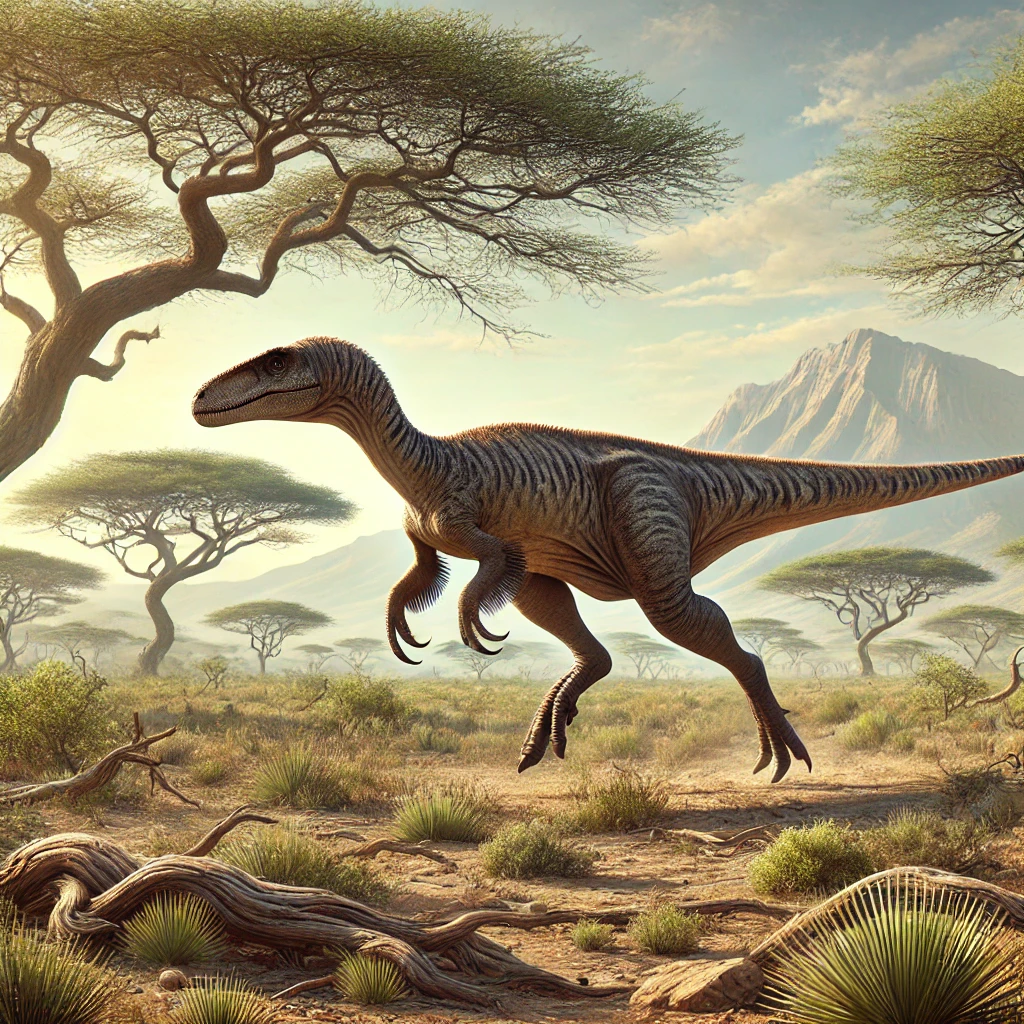Afrovenator
Pronunciation:
Af-roh-ven-ay-tor
Name Meaning:
“African hunter”
Dinosaur Classification:
- Kingdom: Animalia
- Phylum: Chordata
- Class: Reptilia
- Order: Saurischia
- Suborder: Theropoda
- Family: Megalosauridae
- Genus: Afrovenator
- Species: A. abakensis
Dinosaur Description:
Afrovenator, meaning “African hunter,” was a large theropod dinosaur that lived during the Middle Jurassic period, approximately 165 million years ago. It was a bipedal predator, with strong legs built for running and agility. The length of Afrovenator is estimated at about 27 feet (8 meters), making it a medium-sized predator in comparison to some of its larger contemporaries like Allosaurus.
Its body was slender and lightweight, allowing it to be an efficient hunter. Afrovenator likely preyed on herbivorous dinosaurs, using its sharp, recurved teeth to tear into its prey. Its arms were relatively long for a theropod, equipped with three sharp claws that may have helped it grasp prey or hold it while delivering fatal bites.
The skull of Afrovenator was elongated and somewhat flattened, equipped with numerous serrated teeth ideal for slicing through flesh. This suggests that Afrovenator was a carnivore adapted to actively hunting rather than scavenging.
The discovery of Afrovenator is significant because it is one of the few theropods found in Africa from the Jurassic period. Its fossils provide key insights into the diversity of predatory dinosaurs on the African continent during this time. Afrovenator’s classification has been somewhat debated, with some paleontologists placing it within the Megalosauridae family, while others suggest it could belong to the Allosauridae family due to shared characteristics.
Dinosaur Diet and Behavior:
Afrovenator was a carnivore that primarily hunted herbivorous dinosaurs. It likely used its strong legs to run down prey, and its sharp teeth and claws were effective for subduing and dismembering its catches. Like other theropods, Afrovenator may have been a solitary predator, relying on stealth and speed to hunt.
Dinosaur Size:
Afrovenator reached lengths of approximately 27 feet (8 meters) from head to tail.
Dinosaur Weight:
Estimates suggest Afrovenator weighed around 1 ton (2,000 lbs), although it was relatively light for a dinosaur of its size, allowing it greater speed and agility.
Fossil Discoveries:
The first and only significant Afrovenator fossil was discovered in 1993 in the Tiourarén Formation in Niger, Africa. The discovery was made by an expedition led by paleontologist Paul Sereno. The nearly complete skeleton included parts of the skull, vertebrae, limbs, and ribs, providing a comprehensive look at this African predator. Since then, the fossils have been studied to better understand the theropod fauna of Africa during the Jurassic.
What Period Did The Dinosaur Live:
Afrovenator lived during the Middle Jurassic period, around 165 million years ago.
Notable Facts or Trivia:
– Afrovenator is one of the best-known theropods from the Jurassic period in Africa.
– Its name means “African hunter,” a reference to its location and predatory nature.
– Afrovenator’s fossils were discovered by the renowned paleontologist Paul Sereno, who has uncovered many other significant dinosaur fossils.
– It may have had a similar hunting style to Allosaurus, another large Jurassic predator, though it lived in a different geographic region.
Scientific Significance:
The discovery of Afrovenator was significant for understanding the evolutionary history of theropods in Africa. At the time of its discovery, few large theropods were known from Africa, especially from the Jurassic period. Afrovenator provided new information on the distribution of carnivorous dinosaurs across different continents, illustrating that diverse theropod species inhabited Africa during the Jurassic.
Extinction & Legacy:
Afrovenator, like many dinosaurs, became extinct by the end of the Jurassic period, long before the mass extinction event at the end of the Cretaceous. However, its legacy continues in the fossil record, offering important clues about dinosaur diversity and evolution on the African continent. Afrovenator’s discovery helped broaden scientific knowledge of the types of predators that roamed the earth millions of years ago and contributes to ongoing studies of theropod evolution.
